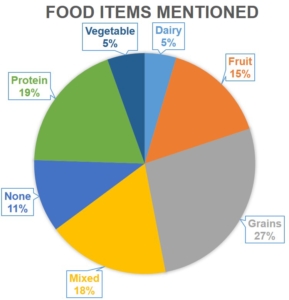The Challenge
My first assignment as a Challenge Detroit fellow was to conduct a food assessment in the 48214 zip code as part of a team of six fellows. Contrary to popular belief, food insecurity is not contained to third world countries far, far away; Hunger affects 1 in 8 Americans. Through our study we learned who these people are and how we might assist them. In our particular assessment area, we found a high concentration of children living in low-income households: two strong indicators of food insecurity. This area also showed low levels of vehicle ownership and therefore limited mobility and longer distances to the nearest grocery stores, reducing access to fresh and healthy food options. Children who suffer from food insecurity are at risk for development set backs and long-term negative effects of food insecurity such as obesity and oral health problems.
The Assessment Method
To find out what students were eating, we went into K-4 classrooms at a local elementary school to talk to the kids about nutrition. We asked students questions like “What does it mean to eat healthy?” and “What are the different food groups?” We then asked students to give examples of what they ate for dinner last night. One student responded “Pizza and breadsticks” and when asked what food group this might fall under, responded “Junk!” Finally, we asked students to draw three circles on a blank sheet of paper, representing their last breakfast, lunch, and dinner plates. We then asked them to draw or write what they had eaten for each of these meals in the last 24 hours.




The Findings
What we found is these children actually know a lot about nutrition and an ideal diet, but their actual diets do not reflect this knowledge. Most students could name the different food groups, noted that portion size is important and mentioned that one must eat foods in each food group to be healthy.
However, only about 20% of student’s diets at home consisted of fruits and vegetables, while the USDA recommendations are 50%. We found that a lot of the students’ diets at home consisted of convenience foods like pizza, fast food, and boxed cereal. We also were able to understand that due to a l ow price per calorie, grains appear to be cheaper and therefore are more heavily consumed in these low-income households. Some students were found to skip meals altogether. Fortunately, almost every student at the school we visited is on the free and reduced lunch program and therefore gets at least one balance meal a day. Detroit Public Schools have also started providing breakfast for these at-risk students and more recently certain schools have started sending a boxed dinner home with some of the most at-risk students.
ow price per calorie, grains appear to be cheaper and therefore are more heavily consumed in these low-income households. Some students were found to skip meals altogether. Fortunately, almost every student at the school we visited is on the free and reduced lunch program and therefore gets at least one balance meal a day. Detroit Public Schools have also started providing breakfast for these at-risk students and more recently certain schools have started sending a boxed dinner home with some of the most at-risk students.
The Conclusion
We concluded that educational interventions with these children’s families to assist them with grocery budgeting and better nutritional value knowledge could lead to a higher level of food security in the area. A long-term solution would be adding a full-service grocery store in the assessment area to also increase the physical accessibility to healthy foods in the locality, particularly in the neighborhood where these low-income households with children are found. In the meantime, our short-term suggestion was to solicit a mobile market presence a few days out of the week. This might prove the feasibility of a permanent market structure and aid the community to attract someone willing to open a new grocery business at this location.

